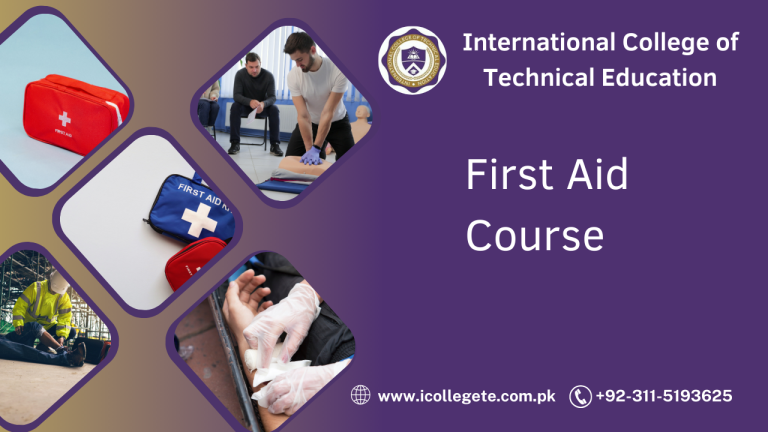In today’s fast-paced industrial and construction environments, ensuring the safety of workers is a top priority. The Occupational Safety and Health Administration (OSHA) 30-Hour course is a comprehensive safety training program designed to provide in-depth knowledge on workplace hazards, safety protocols, and regulatory compliance.
Course Introduction
The OSHA 30-Hour course in Sialkot is a well-established program focused on providing advanced safety training to workers and supervisors across various industries. OSHA, a division of the U.S. Department of Labor, is responsible for regulating and ensuring workplace safety across the United States. While this course is globally recognized, it is especially beneficial for workers in construction and general industries who want to deepen their understanding of safety regulations and practices.
The course provides both theoretical knowledge and practical insights into workplace hazards, safety systems, emergency procedures, and regulatory compliance. Upon completion, participants will have a thorough understanding of OSHA standards and how to apply them to reduce risk and prevent accidents in their respective workplaces.
Course Overview
The OSHA 30-Hour course is divided into several modules that cover a wide array of safety topics. The course is designed for both workers and supervisors, ensuring that participants are well-equipped to identify hazards, respond to emergencies, and comply with OSHA standards.
The OSHA 30-Hour course covers the following key areas:
- Safety and Health Regulations: Understanding the purpose of OSHA, key safety regulations, and their importance in maintaining a safe workplace.
- Hazard Identification and Risk Assessment: How to identify workplace hazards, assess risks, and implement control measures.
- Emergency Procedures: Training on how to respond to workplace emergencies, including fires, chemical spills, and medical emergencies.
- Personal Protective Equipment (PPE): Understanding the importance and correct use of personal protective equipment to prevent workplace injuries.
- Workplace Safety Programs: Creating and implementing safety programs to ensure compliance with regulations and improve safety culture in the workplace.
Throughout the course, participants will be introduced to practical tools and strategies to mitigate risks, reduce workplace injuries, and maintain compliance with OSHA standards.
Study Units
The OSHA 30-Hour course consists of various study units that encompass key aspects of workplace safety:
- Introduction to OSHA and Safety Standards
- Overview of OSHA and its role in workplace safety.
- Understanding the OSHA Act and the importance of compliance.
- The responsibilities of employers and employees under OSHA.
- Workplace Hazards and Risk Assessment
- Identifying common hazards in construction, manufacturing, and general industries.
- Methods for assessing and controlling risks in the workplace.
- Conducting hazard analyses and implementing preventive measures.
- Emergency Procedures and Response Plans
- Developing and implementing emergency response procedures.
- First aid, fire safety, and chemical spill response.
- Emergency evacuation protocols and crowd control measures.
- Personal Protective Equipment (PPE)
- Different types of PPE and their proper usage.
- How to select appropriate PPE for various workplace hazards.
- Maintenance and inspection of PPE.
- Workplace Safety and Health Programs
- Developing effective safety programs tailored to your industry.
- Creating safety protocols, training plans, and awareness programs.
- The importance of safety meetings and employee involvement in safety practices.
- Health and Environmental Issues
- Addressing environmental health risks, such as exposure to hazardous chemicals or noise.
- Understanding the long-term effects of workplace hazards on worker health.
- Regulatory requirements related to health and the environment.
- Ergonomics and Accident Prevention
- Identifying ergonomic hazards and implementing solutions to prevent musculoskeletal injuries.
- Implementing workplace design modifications to improve comfort and reduce injury risks.
- Accident prevention strategies and developing a culture of safety.
Learning Outcomes
By the end of the OSHA 30-Hour course, participants will:
- Gain a comprehensive understanding of OSHA standards and regulations.
- Be equipped to identify and assess workplace hazards.
- Understand how to develop and implement effective workplace safety programs.
- Be able to establish emergency procedures and responses for various types of workplace accidents.
- Learn how to correctly use and maintain personal protective equipment (PPE).
- Gain practical knowledge on ergonomics, risk management, and accident prevention.
- Be capable of fostering a culture of safety and compliance in their workplaces.
Course Benefits
- Enhanced Workplace Safety: The primary benefit of the OSHA 30-Hour course is its ability to enhance workplace safety. Participants will gain the tools needed to identify potential hazards and implement effective control measures.
- Improved Risk Management: The course equips workers and supervisors with the skills to assess risks, prevent accidents, and comply with safety regulations, reducing the likelihood of workplace injuries.
- Professional Development: Completing the OSHA 30-Hour course can enhance your career prospects. The certification is recognized globally and demonstrates your commitment to maintaining a safe and compliant workplace.
- Compliance with Legal Requirements: OSHA certifications are often a legal requirement for certain roles in construction, manufacturing, and other high-risk industries. Completing the course ensures compliance with these regulations and helps businesses avoid legal issues.
- Boosted Employee Confidence: Employees and supervisors who complete this course feel more confident in their ability to maintain a safe working environment. This confidence leads to increased productivity and morale in the workplace.
- Industry Recognition: OSHA 30-Hour certification is recognized across industries. This qualification is often required for those working in high-risk environments and can significantly improve your employability.
Who is This Course For?
The OSHA 30-Hour course is designed for:
- Supervisors and Managers: Those in charge of overseeing workplace safety and ensuring that safety regulations are followed.
- Workers in High-Risk Industries: Employees in construction, manufacturing, logistics, and other high-risk industries who want to enhance their understanding of workplace safety.
- Safety Officers: Individuals responsible for implementing safety programs and ensuring compliance with OSHA regulations.
- Health and Safety Professionals: Those aiming to specialize in workplace safety and hazard management.
- Anyone Seeking OSHA Certification: Individuals who want to gain OSHA certification to enhance their job prospects and advance their careers.
Future Progression for This Course
After completing the OSHA 30-Hour course, participants can pursue further certifications and career opportunities:
- OSHA 40-Hour Course: For individuals seeking more in-depth training, the OSHA 40-Hour course is the next step. This course focuses on more specialized safety topics and is ideal for safety professionals or those in charge of managing large safety programs.
- Safety Management Roles: With an OSHA 30-Hour certification, individuals can progress to higher-level safety management roles, including safety supervisor, safety coordinator, or safety director.
- Certified Safety Professional (CSP): After gaining practical experience and additional qualifications, individuals can pursue the CSP certification, which is recognized globally as a mark of expertise in occupational safety.
- Specialized Safety Courses: Depending on your industry, you may choose to pursue specialized safety courses, such as construction safety, electrical safety, or environmental health and safety (EHS) certifications.
- Workplace Safety Consultant: With OSHA certification and extensive knowledge of workplace safety, you can move into consulting, helping companies to develop and implement safety programs.
The OSHA 30-Hour course in Sialkot is an essential program for individuals looking to enhance their knowledge of workplace safety, particularly those in high-risk industries. With its comprehensive curriculum, the course offers vital insights into hazard identification, risk management, and emergency response. Whether you’re a worker, supervisor, or safety officer, the OSHA 30-Hour certification will equip you with the skills necessary to maintain a safe and compliant workplace, ensuring the well-being of both employees and employers.







